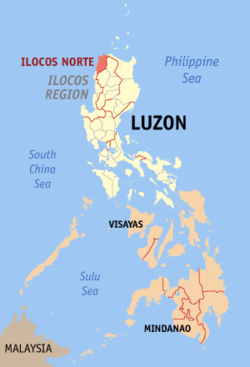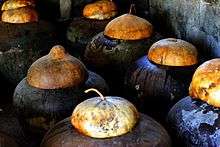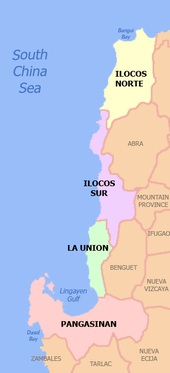Ilocos Norte
| Ilocos Norte | ||
|---|---|---|
| Province | ||
| Province of Ilocos Norte | ||
|
Ilocos Norte Provincial Capitol | ||
| ||
 Location in the Philippines | ||
| Coordinates: 18°10′N 120°45′E / 18.17°N 120.75°ECoordinates: 18°10′N 120°45′E / 18.17°N 120.75°E | ||
| Country | Philippines | |
| Region | Ilocos Region (Region I) | |
| Founded | 1818 | |
| Capital | Laoag | |
| Government | ||
| • Type | Sangguniang Panlalawigan | |
| • Governor | Imee Marcos (NP) | |
| • Vice Governor | Angelo Barba (NP) | |
| Area[1] | ||
| • Total | 3,467.89 km2 (1,338.96 sq mi) | |
| Area rank | 38th out of 81 | |
| Population (2015 census)[2] | ||
| • Total | 593,081 | |
| • Rank | 48th out of 81 | |
| • Density | 170/km2 (440/sq mi) | |
| • Density rank | 52th out of 81 | |
| Divisions | ||
| • Independent cities | 0 | |
| • Component cities | ||
| • Municipalities | ||
| • Barangays | 557 | |
| • Districts | 1st and 2nd districts of Ilocos Norte | |
| Time zone | PHT (UTC+8) | |
| ZIP code | 2900–2922 | |
| IDD : area code | +63 (0)77 | |
| ISO 3166 code | PH-ILN | |
| Spoken languages | ||
| Website |
www | |
Ilocos Norte (Ilocano: Amianan nga Ilocos, Filipino: Hilagang Ilocos) is a province of the Philippines located in the Ilocos Region. Its capital is Laoag City and is located at the northwest corner of Luzon Island, bordering Cagayan to the extreme northeast, Apayao to the east, and Abra to the southeast, and Ilocos Sur to the southwest. Ilocos Norte faces the South China Sea to the west and the Luzon Strait to the north.
Ilocos Norte is noted for being the birthplace of former President Ferdinand E. Marcos, who led an authoritarian rule over the country during the latter half of his incumbency. The Marcoses enjoy a modicum of popularity in the province. Ilocos Norte is also known as a northern tourist destination, being the location of Fort Ilocandia, an upper class hotel and beach resort famous among expatriates, and Pagudpud.
History
Long before the arrival of the Spaniards, there already existed an extensive region (consisting of the present provinces of Ilocos Norte, Ilocos Sur, Abra and La Union) renowned for its gold mines. Merchants from Japan and China would often visit the area to trade gold with beads, ceramics and silk. The inhabitants of the region, believed to be of Malay origin, called their place samtoy, from sao mi toy, which literally meant "our language here"
In 1571, when the Spanish conquistadors had Manila more or less under their control, they began looking for new sites to conquer. Miguel Lopez de Legazpi's grandson, Juan de Salcedo, volunteered to lead one of these expeditions. Together with 8 armed boats and 45 men, the 22-year-old voyager headed north. On June 13, 1572, Salcedo and his men landed in present-day Vigan and then proceeded towards Laoag, Currimao and Badoc. As they sailed along the coast, they were surprised to see numerous sheltered coves (looc) where the locals lived in harmony. As a result, they named the region Ylocos and its people Ylocanos.
As the Christianization of the region grew, so did the landscape of the area. Vast tracts of land were utilized for churches and bell towers in line with the Spanish mission of bajo las campanas. In the town plaza, it was not uncommon to see garrisons under the church bells. The colonization process was slowly being carried out.
The Spanish colonization of the region, however, was never completely successful. Owing to the abusive practices of many Augustinian friars, a number of Ilocanos revolted. Noteworthy of these were the Dingras uprising (1589) and Pedro Almasan revolt (San Nicolas, 1660). In 1762, Diego Silang led a series of battles aimed at freeing the Ilocano. When he died from his compatriot's bullet, his widow Gabriela continued his cause. However, she too was captured and hanged.
In 1807, the sugar cane (basi) brewers of Piddig rose up in arms to protest the government's monopoly of the wine industry. In 1898, the church excommunicated Gregorio Aglipay for refusing to cut off ties with the revolutionary forces of Gen. Emilio Aguinaldo. Unperturbed, he established the Iglesia Filipina Independiente. Aglipay’s movement.
In an effort to gain more political control and because of the increasing population of the region, a Royal Decree was signed on February 2, 1818 splitting Ilocos into two provinces: Ilocos Norte and Ilocos Sur. Soon thereafter, La Union and Abra likewise became independent provinces.
Geography

Ilocos Norte covers a total area of 3,467.89 square kilometres (1,338.96 sq mi)[3] occupying the northern tip of the Ilocos Region in Luzon. The province is bordered by Cagayan to the extreme northeast, Apayao to the east, and Abra to the southeast, Ilocos Sur to the southwest, the South China Sea to the west, and the Luzon Strait to the north.
Administrative divisions
Ilocos Norte comprises 21 municipalities and 2 component cities, further subdivided into 557 barangays. There are two legislative districts in the province.
| ||||||||||||||||||||||||||||||||||||||||||||||||||||||||||||||||||||||||||||||||||||||||||||||||||||||||||||||||||||||||||||||||||||||||||||||||||||||||||||||||||||||||||||||||||||||||||||||||||||||||||||||||||||||||||||||||||||||||||||||||||||||||||||||||||||||||||||||||||||||||||||||||||||||||||||||||||||||||||||||||||||||||||||||||||||||||
Barangays
Ilocos Norte has 557 barangays comprising its 21 municipalities and 2 cities.[4]
The most populous barangay in the province is Barangay No. 1, San Lorenzo (Poblacion) in the City of Laoag with a population of 4,391 in the 2010 census. If cities are excluded, Davila in the municipality of Pasuquin has the highest population, at 3,900. The least populous is Sapat in the municipality of Pasuquin, with only 32.[4]
Demographics
| Population census of Ilocos Norte | ||
|---|---|---|
| Year | Pop. | ±% p.a. |
| 1990 | 461,661 | — |
| 1995 | 482,651 | +0.84% |
| 2000 | 514,241 | +1.37% |
| 2007 | 547,284 | +0.86% |
| 2010 | 568,017 | +1.36% |
| 2015 | 593,081 | +0.83% |
| Source: National Statistics Office[2][4][4] | ||
The population of Ilocos Norte in the 2015 census was 593,081 people,[2] with a density of 170 inhabitants per square kilometre or 440 inhabitants per square mile.
Religion
Roman Catholicism and the Aglipayan Church are the two major religions in the province.
Among the major Roman Catholic churches in Ilocos Norte include:
- Paoay Church — named a UNESCO World Heritage Site in 1993.
- St. William's Cathedral in Laoag — known for its Sinking Bell Tower
- Santa Monica Church in Sarrat — documented to be the biggest church in the Ilocos Region.
- Bacarra Church — destroyed during an intensity VII (on the Rossi-Forel scale) earthquake on August 17, 1983,[5] reconstructed and re-inaugurated in 1984.
Ilocos Norte is the home of the Aglipay Shrine (Aglipayan Church) where the church's first supreme leader was buried.There are also increasing members of Jehovah's Witnesses. There are also minor but steadily increasing members of Iglesia ni Cristo. Islam is also practiced by Mindanaoan traders and immigrants.
Economy

The province specializes in the following products and industries:
- Agriculture — rice, corn, garlic, legumes, root crops, tobacco, and other fruits and vegetables
- Fishery — tilapia and assorted fishes
- Livestock — swine and cattle
- Cottage industries — loom weaving, furniture, ceramics, iron works
- Manufacturing and food processing — salt, empanada, bagoong, patis, basi (native Ilocano wine), vinegar, longganisa, chicharon, bagnet, chichacorn (cornick), jewelry, garments, cereal processing, packaging, mechanized processing equipment
- Wind Power — Ilocos Norte's position on the northwest corner of Luzon makes it ideal for wind power generation. There is currently a 25 Megawatt wind farm in Ilocos Norte, and several more wind energy projects are being planned
- Tourism
- Pottery
Provincial Government
Term of Office: June 30, 2016 - June 30, 2019
- Governor: Maria Imelda R. Marcos
- Vice - Governor: Eugenio Angelo M. Barba
Representatives:
- Rodolfo C. Fariñas (1st District)
- Imelda R. Marcos (2nd District)
Sangguniang Panlalawigan Members:
1st District
- Ria Christina G. Fariñas
- Juan Conrado A. Respicio II
- Vicentito M. Lazo
- Donald G. Nicolas
- Rogelio R. Balbag
2nd District
- Matthew Joseph M. Manotoc
- Mariano V. Marcos II
- Ramon M. Gaoat
- Da Vinci M. Crisostomo
- James Paul C. Nalupta
Ex Officio Members
- PCL President: Domingo C. Ambrocio
- ABC President: Paulino Baltazar
References
- ↑ "List of Provinces". PSGC Interactive. Makati City, Philippines: National Statistical Coordination Board. Archived from the original on January 21, 2013. Retrieved 26 September 2013.
- 1 2 3 4 "Region I (ILOCOS REGION)". Census of Population (2015): Total Population by Province, City, Municipality and Barangay (Report). PSA. Retrieved 20 June 2016.
- 1 2 3 "Province: Ilocos Norte". PSGC Interactive. Quezon City, Philippines: Philippine Statistics Authority. Retrieved 8 January 2016.
- 1 2 3 4 5 "Region I (ILOCOS REGION)". Census of Population and Housing (2010): Total Population by Province, City, Municipality and Barangay (Report). NSO. Retrieved 29 June 2016.
- ↑ "Laoag Earthquake - 17 August 1983". Phivolcs. 1983. Retrieved 2011-01-02.
External links
-
 Media related to Ilocos Norte at Wikimedia Commons
Media related to Ilocos Norte at Wikimedia Commons -
 Geographic data related to Ilocos Norte at OpenStreetMap
Geographic data related to Ilocos Norte at OpenStreetMap - Ilocos Norte Official Website
 |
South China Sea | Cagayan |  | |
| South China Sea | |
Apayao | ||
| ||||
| | ||||
| Ilocos Sur, Abra |





